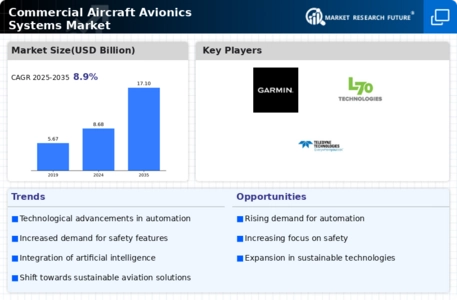Increased Demand for Air Travel
The Commercial Aircraft Avionics Systems Market is benefiting from the increased demand for air travel, which has been steadily rising due to globalization and economic growth. As more passengers opt for air travel, airlines are compelled to expand their fleets and upgrade their avionics systems to accommodate this growth. The International Air Transport Association (IATA) projects that air passenger numbers will reach 8.2 billion by 2037, indicating a robust demand for new aircraft equipped with advanced avionics. This surge in demand is likely to drive investments in avionics technologies, as airlines seek to enhance passenger experience and operational efficiency. Consequently, the avionics market is poised for significant growth as it adapts to the evolving needs of the aviation industry.
Emerging Markets and Regional Growth
The Commercial Aircraft Avionics Systems Market is witnessing growth in emerging markets, where increasing disposable incomes and urbanization are driving air travel demand. Regions such as Asia-Pacific and Latin America are experiencing rapid economic development, leading to a surge in the number of airlines and aircraft operations. This trend is prompting investments in modern avionics systems to ensure safety and efficiency in operations. According to market forecasts, the Asia-Pacific region is expected to account for a substantial share of the avionics market, driven by the expansion of low-cost carriers and increased air traffic. As these emerging markets continue to develop, the demand for advanced avionics solutions is likely to rise, presenting significant opportunities for manufacturers and suppliers in the industry.
Technological Advancements in Avionics
The Commercial Aircraft Avionics Systems Market is experiencing a surge in technological advancements, particularly in the areas of automation and digitalization. Innovations such as fly-by-wire systems and advanced navigation technologies are enhancing aircraft performance and safety. The integration of artificial intelligence and machine learning into avionics systems is also becoming more prevalent, allowing for predictive maintenance and improved decision-making capabilities. According to recent data, the avionics market is projected to grow at a compound annual growth rate of approximately 5.5% over the next several years, driven by these technological innovations. As airlines and manufacturers seek to enhance operational efficiency and reduce costs, the demand for advanced avionics systems is likely to increase, further propelling the market forward.
Regulatory Compliance and Safety Standards
The Commercial Aircraft Avionics Systems Market is significantly influenced by stringent regulatory compliance and safety standards imposed by aviation authorities. Organizations such as the Federal Aviation Administration (FAA) and the European Union Aviation Safety Agency (EASA) continuously update regulations to ensure the highest safety levels in aviation. Compliance with these regulations often necessitates the adoption of advanced avionics systems that meet or exceed safety requirements. This has led to an increased demand for modern avionics solutions, as airlines and manufacturers strive to maintain compliance while enhancing operational safety. The market is expected to witness a steady growth trajectory as companies invest in avionics upgrades to adhere to evolving regulations, thereby ensuring the safety and reliability of their aircraft.
Sustainability Initiatives and Environmental Concerns
The Commercial Aircraft Avionics Systems Market is increasingly shaped by sustainability initiatives and growing environmental concerns. As the aviation sector faces pressure to reduce its carbon footprint, there is a rising demand for avionics systems that support fuel efficiency and lower emissions. Technologies such as advanced flight management systems and optimized routing capabilities are being developed to enhance fuel efficiency, thereby contributing to sustainability goals. According to industry reports, the market for eco-friendly avionics solutions is expected to expand as airlines seek to align with global sustainability targets. This trend not only addresses environmental concerns but also enhances the overall operational efficiency of aircraft, making it a critical driver in the avionics market.

















Leave a Comment